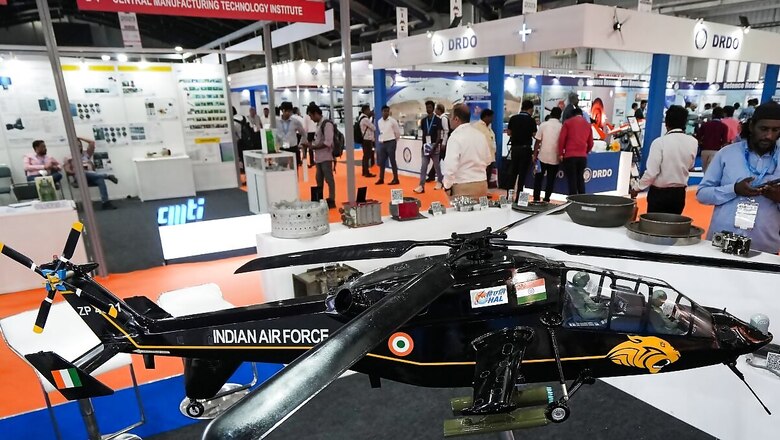
views
India is witnessing a remarkable industrial surge, fuelled by the central government’s ambitious ‘Make in India’ initiative. A decade after its launch in 2014, it aims to transform India into a global manufacturing powerhouse and the impact is evident. From traditional industries like toy manufacturing to cutting-edge fields like semiconductor fabrication and defence production, sectors are seeing an incredible surge.
Let us take a deep dive.
Strategic shift: India’s defence sector embraces self-reliance
The defence sector is undergoing a significant and deliberate transformation. Moving away from its historical reliance on imports, the country is embracing a future defined by self-reliance and indigenous manufacturing capabilities.
This strategic shift, spearheaded by the ‘Aatmanirbhar Bharat’ initiative, is reshaping India’s defence landscape and positioning the country as a potential global force in defence production. At the heart of this transformation is a series of concrete policy measures designed to incentivise domestic production and reduce import dependency.
The Interim Budget 2024-25 allocated a substantial Rs 1.72 lakh crore for modernisation and infrastructure development within the defence sector, a clear indication of the government’s commitment. This represents a 9.4 percent increase compared to the previous year.
Further, the ministry of defence has set a bold target of achieving a Rs 1.75 lakh crore turnover in aerospace and defence manufacturing by 2025. This vision includes a notable export target of Rs 35,000 crore, highlighting the Centre’s ambition to establish India as a major player in the global defence market.
Several initiatives form the backbone of this ambitious self-reliance strategy. The Defence Acquisition Procedure (DAP) 2020 stands as a cornerstone, prioritising indigenous design and development of defence equipment while simultaneously encouraging foreign direct investment (FDI) to establish manufacturing hubs within India.
A crucial element of DAP 2020 is the implementation of positive indigenisation lists, which encompass more than 5,000 items. These act as a roadmap for domestic production, clearly identifying the defence items that will be manufactured in India and, hence, gradually decreasing reliance on foreign suppliers.
The effectiveness of this approach is demonstrably evident in the explosive growth of India’s defence exports, which have experienced a remarkable 21-fold rise in the last decade, surging from Rs 4,312 crore during 2004-05 to 2013-14 to a substantial Rs 88,319 crore from 2014-15 to 2023-24, as per government data.
The tangible outcomes of this strategic shift are already taking shape, exemplified by the case of Dassault Aviation’s Rafale fighter jets. While India initially acquired 36 Rafale fighters, the country’s aspirations extend beyond mere procurement.
Dassault Aviation is now in the process of acquiring land near Jewar International Airport to establish a dedicated maintenance, repair and overhaul (MRO) facility for India’s existing Mirage 2000 and Rafale fighters. The move paves the way for local production of the latest Rafale versions in India, aligning with the core principles of the ‘Make in India’ initiative. The long-term requirement of the Indian Air Force for approximately 100 twin-engine multirole fighters over the next two decades, coupled with Dassault’s backlog of 300 fighter orders from other countries, presents a compelling opportunity.
Defence exports have continued their upward climb, reaching a record Rs 21,083 crore (approximately $2.63 billion) in the financial year 2023-24. This represents a healthy 32.5 percent growth over the previous fiscal, showcasing the sustained momentum of India’s indigenous defence production.
The remarkable growth in defence manufacturing and exports has generated a ripple effect, propelling the stock prices of many public sector units (PSU) involved in defence production to new heights. Adding to this positive trend is the noteworthy rise in the number of export authorisations issued to defence exporters in 2023-24, jumping from 1,414 in 2022-23 to 1,507, demonstrating the expanding reach of India’s defence products in the international market.
India’s defence sector is demonstrably at an inflection point.
Toys: From net importer to global contender
India’s toy industry has undergone a remarkable transformation, evolving from a net importer to a global exporter. This turnaround is largely attributed to a series of strategic government policies designed to stimulate domestic production and curb imports.
A key policy intervention was the significant increase in import duty on toys, rising from 20 percent in 2019 to a substantial 70 percent in 2023. This effectively made imported toys, predominantly from China, significantly more expensive, establishing a level playing field for Indian manufacturers.
The consequence was a sharp decline in imports, shrinking by a substantial 79 percent between FY19 and FY24, as reported by the Global Trade Research Initiative (GTRI). Simultaneously, the government implemented a quality control order (QCO) in January 2021. This mandated that all toys sold in India, regardless of origin, adhere to the Indian Standards on Toys, ensuring children’s safety from substandard or unsafe products and bolstering the ecosystem for quality toy manufacturing within India.
The impact of these policies is reflected in the impressive 40 percent surge in toy exports between FY19 and FY24, showcasing the industry’s newfound global competitiveness.
Semiconductors: Attracting global giants, fostering domestic innovation
India’s semiconductor sector is experiencing a period of rapid growth, attracting significant investments from international giants like Micron Technology while simultaneously fostering the emergence of promising domestic startups. The cornerstone has been a substantial Rs 760 billion (over US$10 billion) package, announced in December 2021, aimed at stimulating both semiconductor and display manufacturing.
The package is designed to incentivise companies operating across the entire semiconductor value chain, from the complex process of fabrication to the crucial stage of assembly, testing, marking, and packaging (ATMP/OSAT). It seeks to position India as a global hub for electronics manufacturing, offering incentives of an impressive Rs 2.3 trillion (approximately US$30.16 billion) to attract investors.
Micron Technology, the world’s fifth-largest semiconductor company, has responded to this attractive proposition. The company announced a US$2.75 billion investment to establish an ATMP facility in Gujarat, a project projected to create 5,000 new jobs. This significant investment, which received approval from the Union Cabinet in June 2023, serves as a testament to the government’s commitment to drawing in major global players.
The government is concurrently focused on nurturing domestic startups through initiatives like the design linked incentive (DLI) scheme, which provides vital financial incentives and much-needed infrastructure support to Indian companies engaged in semiconductor design. The ultimate goal is to stimulate the creation of valuable domestic intellectual property and enhance indigenous chip design capabilities. It is a dual strategy of attracting global expertise and simultaneously cultivating homegrown talent.
According to a PIB update, the construction of four previously approved semiconductor units is rapidly progressing, contributing to the development of a robust semiconductor ecosystem. These units, encompassing a Tata-PSMC commercial fab plant and three ATMP/OSAT plants, are attracting nearly Rs 1.5 trillion (US$18.15 billion) in investment. These projects are collectively expected to have a combined production capacity of approximately 70 million chips per day, signifying a substantial increase in India’s chipmaking capacity.
The success stories across these diverse sectors demonstrate the ‘Make in India’ initiative’s impact in stimulating industrial growth, enhancing economic resilience, and promoting global integration. By creating a conducive business environment, incentivising investments, and making domestic manufacturing a priority, the government is laying the foundation for a more competitive and self-reliant economy. It is poised to play a significant role in the intricate network of global supply chains and, while challenges remain, the progress made across these critical sectors suggests that the ‘Make in India’ initiative is delivering on its promise of transforming India into a global manufacturing powerhouse.
(Views expressed in the above piece are personal and solely those of the author. They do not necessarily reflect News18’s views)



















Comments
0 comment